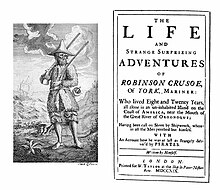Robinson Crusoe
Robinson Crusoe is a novel written by Daniel Defoe. It was first published on 25 April 1719 by William Taylor.[2]: xxv
 Title page from the first edition | |
| Author | Daniel Defoe |
|---|---|
| Illustrator | Single engraving by John Clark and John Pine after design by unknown artist[1] |
| Country | United Kingdom |
| Language | English |
| Genre | adventure, historical fiction |
| Publisher | W. Taylor |
Publication date | 25 April 1719 |
| Followed by | The Farther Adventures of Robinson Crusoe |
The novel's full title is The Life and Strange Surprizing Adventures of Robinson Crusoe, Of York, Mariner: Who lived Eight and Twenty Years, all alone in an un-inhabited Island on the Coast of America, near the Mouth of the Great River of Oroonoque; Having been cast on Shore by Shipwreck, wherein all the Men perished but himself. With An Account how he was at last as strangely deliver'd by Pyrates.[2]: iii
The book is a fictional autobiography of the title character, Robinson Crusoe. Crusoe leaves the safety of his comfortable middle-class home in England and goes to sea. He is shipwrecked and becomes a castaway who spends years on a remote tropical island near Trinidad. He meets cannibals, captives and mutineers, and is eventually rescued.
For the first edition, Defoe pretended that the novel was a true story. He said the fictional protagonist Robinson Crusoe was the author and he pretended to be the editor of Crusoe's autobiography.[2]: vii This led many readers to believe that Crusoe was a real person and the book a true account of his life.
Many people think the story was influenced by the life of Alexander Selkirk.[3] Selkirk was a Scottish castaway who lived for over four years on a Pacific island belonging to Chile called Más a Tierra. (In 1966, the island was renamed Robinson Crusoe Island.) However, there are other possible sources. For example, Ibn Tufail's earlier novel Hayy ibn Yaqdhan, also set on a desert island, may have inspired Defoe.
Critical response to Robinson Crusoe has been diverse and argumentative. There has been widespread disagreement about the novel's nature and origin, values, structure, and meaning. Literary historians have not agreed on Defoe's sincerity, exact intentions, and achievement in the book.[2]: viii
Robinson Crusoe was very popular as soon as it was published. Before the end of 1719, it had already run through four editions.[2]: xxv The novel's popularity has continued and it has become one of the most widely published books in history. It has prompted many imitations and adaptations for stage, film, and television.
References
change- ↑ "The Primitive Crusoe, 1719–1780". Picturing the First Castaway: the Illustrations of Robinson Crusoe - Paul Wilson and Michael Eck. Archived from the original on 28 March 2013. Retrieved 25 June 2012.
- ↑ 2.0 2.1 2.2 2.3 2.4 Defoe, Daniel (1983) [1719]. Crowley, J. Donald (ed.). Robinson Crusoe (The World's Classics ed.). Oxford University Press. ISBN 0-19-281555-5.
- ↑ "Robinson Crusoe (novel by Defoe)". Encyclopædia Britannica. Encyclopædia Britannica, Inc. Retrieved 2013-11-11.